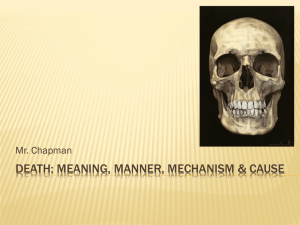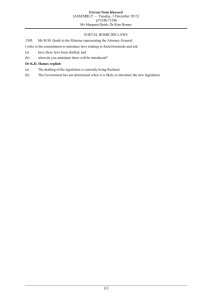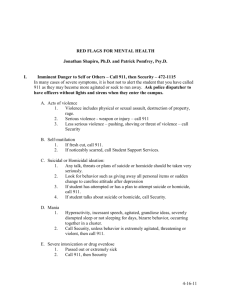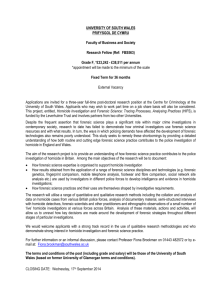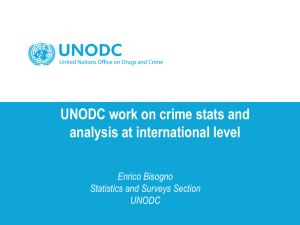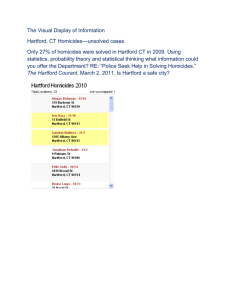analysis of homicidal deaths in peshawar, pakistan
advertisement
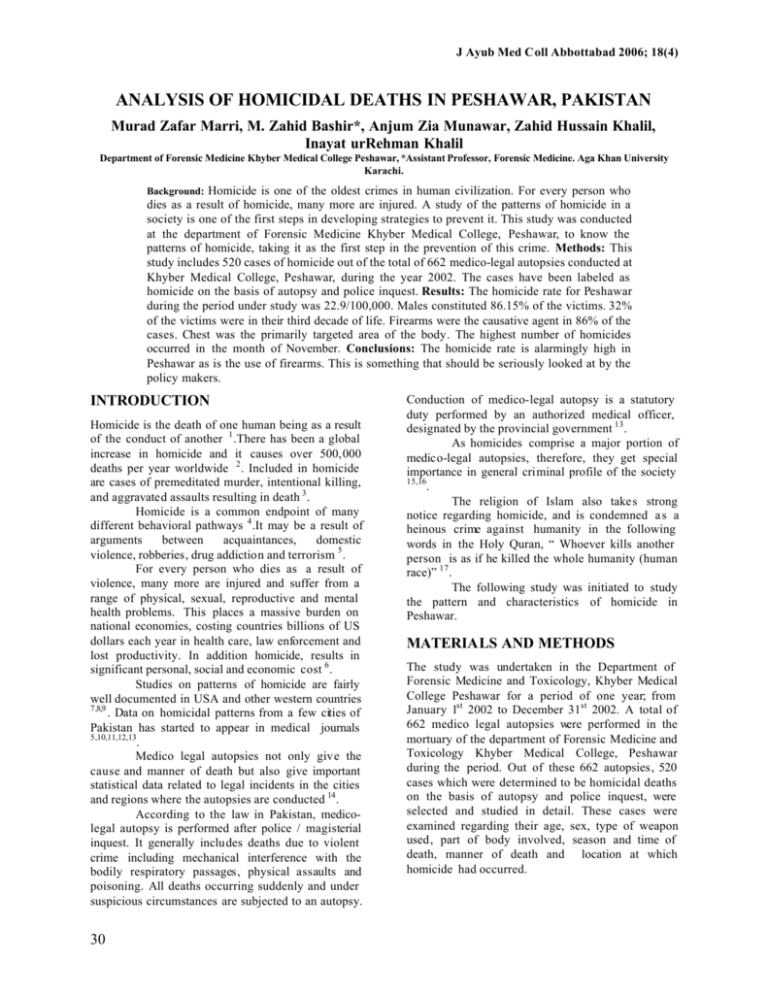
J Ayub Med Coll Abbottabad 2006; 18(4) ANALYSIS OF HOMICIDAL DEATHS IN PESHAWAR, PAKISTAN Murad Zafar Marri, M. Zahid Bashir*, Anjum Zia Munawar, Zahid Hussain Khalil, Inayat urRehman Khalil Department of Forensic Medicine Khyber Medical College Peshawar, *Assistant Professor, Forensic Medicine. Aga Khan University Karachi. Background: Homicide is one of the oldest crimes in human civilization. For every person who dies as a result of homicide, many more are injured. A study of the patterns of homicide in a society is one of the first steps in developing strategies to prevent it. This study was conducted at the department of Forensic Medicine Khyber Medical College, Peshawar, to know the patterns of homicide, taking it as the first step in the prevention of this crime. Methods: This study includes 520 cases of homicide out of the total of 662 medico-legal autopsies conducted at Khyber Medical College, Peshawar, during the year 2002. The cases have been labeled as homicide on the basis of autopsy and police inquest. Results: The homicide rate for Peshawar during the period under study was 22.9/100,000. Males constituted 86.15% of the victims. 32% of the victims were in their third decade of life. Firearms were the causative agent in 86% of the cases. Chest was the primarily targeted area of the body. The highest number of homicides occurred in the month of November. Conclusions: The homicide rate is alarmingly high in Peshawar as is the use of firearms. This is something that should be seriously looked at by the policy makers. INTRODUCTION Homicide is the death of one human being as a result of the conduct of another 1 .There has been a global increase in homicide and it causes over 500,000 deaths per year worldwide 2 . Included in homicide are cases of premeditated murder, intentional killing, and aggravated assaults resulting in death 3 . Homicide is a common endpoint of many different behavioral pathways 4 .It may be a result of arguments between acquaintances, domestic violence, robberies, drug addiction and terrorism 5 . For every person who dies as a result of violence, many more are injured and suffer from a range of physical, sexual, reproductive and mental health problems. This places a massive burden on national economies, costing countries billions of US dollars each year in health care, law enforcement and lost productivity. In addition homicide, results in significant personal, social and economic cost 6 . Studies on patterns of homicide are fairly well documented in USA and other western countries 7,8,9 . Data on homicidal patterns from a few cities of Pakistan has started to appear in medical journals 5,10,11,12,13 . Medico legal autopsies not only give the cause and manner of death but also give important statistical data related to legal incidents in the cities and regions where the autopsies are conducted 14 . According to the law in Pakistan, medicolegal autopsy is performed after police / magisterial inquest. It generally includes deaths due to violent crime including mechanical interference with the bodily respiratory passages, physical assaults and poisoning. All deaths occurring suddenly and under suspicious circumstances are subjected to an autopsy. 30 Conduction of medico-legal autopsy is a statutory duty performed by an authorized medical officer, designated by the provincial government 13 . As homicides comprise a major portion of medico-legal autopsies, therefore, they get special importance in general criminal profile of the society 15,16 . The religion of Islam also takes strong notice regarding homicide, and is condemned a s a heinous crime against humanity in the following words in the Holy Quran, “ Whoever kills another person is as if he killed the whole humanity (human race)” 17 . The following study was initiated to study the pattern and characteristics of homicide in Peshawar. MATERIALS AND METHODS The study was undertaken in the Department of Forensic Medicine and Toxicology, Khyber Medical College Peshawar for a period of one year; from January 1st 2002 to December 31st 2002. A total of 662 medico legal autopsies were performed in the mortuary of the department of Forensic Medicine and Toxicology Khyber Medical College, Peshawar during the period. Out of these 662 autopsies, 520 cases which were determined to be homicidal deaths on the basis of autopsy and police inquest, were selected and studied in detail. These cases were examined regarding their age, sex, type of weapon used, part of body involved, season and time of death, manner of death and location at which homicide had occurred. J Ayub Med Coll Abbottabad 2006; 18(4) During the period of our study a total of 520 deaths were confirmed as homicidal out of 662 autopsies conducted in the department, thus constituting 78.55% of all deaths reported for autopsy. The district of Peshawar was having a population of 2.26million during the study period. Thus the rate of homicide comes out to be 22.99 per 100,000 populations. The males (86.15%) outnumbered the females (13.85% ) with a ratio of 6.2:1 Table-1: Sex distribution in homicidal cases. Sex Male Female Number of victims 448 (86.15%) 072 (13.85%) The victims were mostly young people in their prime and productive years of life. 62.1% lying between the ages of 20 and 39 years of age. The extremes of ages were the least vulnerable to homicide with 2.3% up to 9 years of age and 2.1% above the age of 70. Table-2: Age distribution of homicide victims Age group (in years). 0– 9 10 – 19 20 – 29 30 – 39 40 – 49 50 – 59 60 – 69 70 – 79 80 and onward Total Number of victims (%) 12 (2.30%) 36 (6.92%) 168 (32.30%) 155 (29.80%) 70 (13.46%) 44 (8.46%) 27 (15.19%) 07 (1.34%) 01 (0.85%) 520 Firearms were responsible for 86% of the homicides followed by asphyxiation and sharp weapons. Other means to cause homicide are given in Table-3. Table-3: Weapons / Me thods Causing Homicide Types of weapons Firearm Sharp Blunt Strangulation/asphyxiation Poisoning Burning Explosive Number of cases (%) 447 (85.96%) 25 (4.81%) 06 (1.15%) 27 (5.19%) 02 (0.38%) 02 (0.38%) 11 (2.12%) Most of the cases had more then one injury involving multiple sites of the body. The maximum numbers of injuries were inflicted on the chest followed by the head. The upper limbs and lower limbs sustained minimum number of fatal injuries. Table-4 shows the part of the body involved in fatal injuries. Table-4: Area of the body involved in fatal injury Area involved Head Neck Chest Abdomen Upper limbs Lower limbs Total TYPE OF WEAPON Firearm Sharp Blunt 176 (29.13%) 9 (30%) 4 (100%) 29 (4.80%) 9 (30%) 0 225 (37.25%) 7 (23.33%) 0 163 (26.98%) 5 (16.66%) 0 03 (0.49%) 0 0 08 (1.32%) 0 0 604 30 04 51.15% of the victims died during the night time i.e. 6 pm to 6 am, and 48.85% during the day time. The highest number of homicides occurred in the month of November followed July and April as is evident from figure 1. Figure 1: Month wise variation in homicide 70 60 50 No.Of Cases RESULTS 40 30 20 10 0 Jan Feb Mar Apr May Jun Jul Aug Sept Oct Nov Dec DISCUSSION During the period understudy, 78.55% of all deaths reporting for autopsy at the department of Forensic Medicine and Toxicology Khyber Medical College Peshawar were determined to be homicidal in manner. These results are similar to the figures of cities like Bahawalpur and Faisalabad, where 80% of all cases autopsied were homicides.18,19 However lower figures have been reported for Nawabshah (62%) 20 .This may be because of the low level of urbanization and industrialization in Nawabshah with the relative intactness of the usual institutional methods of social control. The homicide rate of 22.99 per 100,000 population per year is one of the highest reported in the world with only South Africa, Columbia and Estonia reporting higher rates.21 This could be because of the high rate of gun possession in the area under study especially automatic weapons. Another reason could be a lack of confidence in the judicial system with people tending to take the law into their own hands for settling differences and disputes. In our study of 520 homicidal deaths, 448 (86.15%) were male and 72 (13.85%) were fema le, forming a male to female ratio of 6.22:1. It is similar to that reported in Bahawalpur (6.82:1)11 and 31 J Ayub Med Coll Abbottabad 2006; 18(4) Abbottabad (6.8:1) 5 , but is much higher than that in Faisalabad (3.47:1) 22 .This may be explained by the structure of society in Peshawar and other areas with high male to female ratio where females are primarily confined to their homes and are therefore protected from being involved in violence. This is in contrast to the more industrialized places like Faisalabad where females are more actively involved in workplaces and play a relatively proactive role thereby exposing them to a pattern of violence and homicide similar to that in males. Our study showed 62.11% of all homicides occurred in age groups between 20-39 years of age, with 32.3% in the third decade of life. Other studies in Pakistan also give the highest occurrence of homicide in the same age group, with 28-40% of all homicides being in the age bracket of 20-29 years 5,10,11,12,1 3,22 . Studies in India and Turkey have also reported this age group to be the most vulnerable 14,2 3,24 , while studies in U.S.A indicate the highest rates at an earlier age (10-25 years) 7,25,26 . This difference could be because individuals start a more independent life at an earlier age in U.S.A thus exposing them to all sorts of violence, something also reflected by the increasing incidence of juvenile offenders and school violence. The weapon most often used to inflict homicide was a firearm (85.96%). This is the highest use of firearms reported in Pakistan. Other studies have reported the use of firearms in 41-58% cases of homicide 5,10,11,12,13,22. Other countries also report a lower use of firearms for homicide.14,24 This could be explained by the free availability of firearms in Peshawar where virtually every household keeps a firearm weapon. Thus whenever a dispute of any sort takes place, the use of a gun is inevitable. This is in keeping with other studies in countries where gun control laws are lax or non existent 27,28 The area of the body targeted in case of firearms was the chest followed by the abdomen and head while in case of sharp weapons it was the head and neck region and exclusively the head for homicide by blunt means. This is consistent with the area of the various regions of the body and the general concept of the lethality of various regions by a particular means. Other studies also show a similar pattern of involvement of the various parts of the body 5, 21,29 . country though they are at present a step behind in terms of the figures for Peshawar. REFERENCES 1. 2. 3. 4. 5. 6. 7. 8. 9. 10. 11. 12. 13. 14. 15. 16. 17. 18. 19. 20. CONCLUSION The homicide rate in Peshawar is alarmingly high as is the percentage of homicides being caused by firearms. This should act as an eye opener for all actors in civil society. It is time we start acting in the direction of controlling the possession of firearms as similar patterns are emerging in other parts of the 32 21. 22. Mant AK. Taylor’s Principles and Practice of Medical Jurisprudence. 13 thed. New Delhi: B.I. Churchill Livingstone, 1994: 215. Reza A, Mercy JA, Krug E. Epidemiology of Violent Deaths in the World. Injury Prevention. 2001; 7:104-11. Fornes P, Druilhe L, Lecomte D. Homicide among youth and young adults, 15 through 29 years of age. A report of 138 cases from Paris and its suburbs 1991-1993. J. Forensic Sci.. 1996; 41 (5): 837-840. Rosenburg ML, Mercy JA. Assaultive Violence. In: Rosenberg ML, Finley MA (Eds) Violence in America, a public health approach. Oxford: Oxford University Press, 1991:14-50. Hasan Q, Shah MM, Bashir MZ. Homicide in Abbottabad. J Ayub Med Coll Abbottabad, 2005; 17 (1): 78-80. Whitman S, Benbow N, Good G. The epidemiology of homicide in Chicago. J Natl Med Assoc. 1996; 88(12):781-7. Chu LD, Sorenson SB. Trends in California Homicide, 1970 to 1993. West J Med. 1996; 165(3):119-25. Shahpar C, Li G. Homicide mortality in the United States, 1935-1995 Age, period and cohort effect. Am J epidemiolo gy.1999; 50 (11): 1213 – 22. Lowry PW, Hassig SE, Gunn RA. Mathison JB. Homicide victims in New Orleans, recent trends. Am J Epidemiology . 1988; 128(5): 1130-6. Aziz K, Rana P. Malik SA. Homicide in Lahore Pakistan. Postgraduate Medical Journal 1999; 10 (1): 10-13. Ali SMA, Rizvi SIH, Ali MA, Chaudhry TH. Weaponry Patterns in the homicidal deaths in Bahawalpur. The Professional. 2000; 7(4): 514 – 6. Qadir G, Aziz K. The study of Homicidal deaths in Larkana. Post Graduate Medical Journal 2000; 11 (2): 79-80. Memon MU, Khalil ZH, Aziz K, Kaheri GQ, Khalil IR. Audit of cases autopsied in the mortuary of Khyber Medical College Peshawar during the year 1999. ANNALS. 2001; 7 (3):190- 3. Ahmet H, Nemci C, Mete K, Gulmen M, Hakan O, Ramzan K. Homicide in Adana, Turkey – A 5-year review. Am J Forensic Medicine and Pathology.2005; 26 (2):141 – 145. Demetriades D,Murray J,Sinz B, Myles D, Chan L, Sathyaraqiswaran L et al. Epidemiology of major trauma and trauma deaths in Los Angeles County. J Am Coll Surg. 1998; 187(4): 373-83. Hougen HP, Rogde S, Poulsen K. Homicide in two Scandinavian capitals. Am J Forensic Med Pathol 2000; 21:281-6. Holy Quran Surah Al Maida, verse 32____. Ali SMA, Ahmed R, Rehman AU. Involvement of manners and modalities in medico-legal deaths in Bahawalpur. The Professional 2000; 7 (2): 234 – 8. Saeed A, Bashir MZ, Munawar AZ, Iqbal J, Ali SMA, Khalil IU. Analysis of medico-legal autopsies at Faisalabad. The Professional 2003; 10 (2): 132 – 41. Sahito MM, Mughal MI, Chang F, Shah SMH, Pirzada SG, Jamali YA et al. Causes of death in interior Sindh A medicolegal autopsies study. Postgraduate Med J 2002; 13 (4): 161-4. International homicide comparisons. Guncite [ homepage on the internet][updated 2006 May 20; cited 2007 Jan 24].Available from http:// www.guncite.com / gun_ control_ gcgvinco.html Bashir MZ, Saeed A, Khan D, Aslam M, Iqbal J, Ahmed M. Pattern of Homicidal deaths in Faisalabad. J Ayub Med Coll Abbottabad 2004; 16(2):57-9. J Ayub Med Coll Abbottabad 2006; 18(4) 23. Mohanty MK, Kumar TS, Mohanram A, Palimar V. Victims of homicidal deaths-An analysis of variables. J Clin Forensic Med 2005; 12(6):302-4. 24. Gupta A, Rani M, Mittal AK, Dikshit PC. A study of homicidal deaths in Delhi. Med Sci Law 2004; 44(2): 127-32. 25. Wintemute FJ. The future of firearm violence prevention. JAMA.1999; 282:175-78. 26. Federal Bureau of Investigation and Reports. Trends in rate of homicide-United States MMWR1996; 7;45(22):460-4. 27. Cheng TL, Wright JL, Fields CB, Brenner RA, O’donnell R, Scwarz D et al. Violent injuries among adolescents: declining morbidity and mortality in an urban population. Ann Emerg Med 2001; 37 (3): 292-300. 28. Zautcke JL, Morris RW, Koenigsberg M, Carmody T, Stein-Spencer L, Erickson TB. Assaults from penetrating trauma in the state of Illinois. Am J Emerg Med 1998; 16 (6):553-6. 29. Elfawal MA, Award OA. Firearm fatalities in Eastern Saudi Arabia. Am J Forensic Med Pathol.1997; 18 (4):391-6. ______________________________________________________________________________ Address for Correspondence: Dr. M. Zahid Bashir, Assistant Professor, Forensic Medicine, Aga Khan University, Stadium Road, P.O. Box 3500, Karachi. E-mail: zahidbash@yahoo.com. 33


